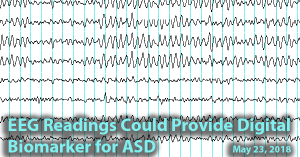Check out other stories from the Latest News
Inexpensive Brain Scans Could Predict Autism Spectrum Disorder
By Chelsea Toledo, M.A. on May 23, 2018

Background: A reliable biomarker for early detection of autism is critical. Electroencephalography (EEG), a technique for recording and mapping electrical activity in the brain – could provide such a measure. During this non-invasive and relatively inexpensive procedure, small metal discs called electrodes are placed on the scalp to detect fluctuations in the voltage given off by the brain’s neurons over time.
What’s New: In a new study, researchers assessed whether EEG data could accurately predict emergence of Autism Spectrum Disorder (ASD) in very young children. They performed EEG procedure on 99 high-risk children (defined as having an older sibling with ASD) and 89 age-matched controls up to seven times, beginning when the children were as young as 3 months old and ending when the children were 3 years old.
The researchers found:
- Patterns in EEG data allowed researchers to predict nearly 100 percent of ASD cases prospectively diagnosed using the Autism Diagnostic Observation Schedule (ADOS) at either 18, 24, or 36 months of age.
- The EEG data also helped predict the severity of ASD as early as 3 months of age.
- Significant differences were evident between the EEG data of the high-risk versus the low-risk group. These differences were most pronounced at 12 months of age.
Why it’s important: This study suggests that EEG could be a useful tool, along with behavioral analyses, for diagnosing ASD early. Research has shown that early diagnosis is associated with improved outcomes for children with ASD.
Help me understand :
| Source(s) : |
| Tweet |

